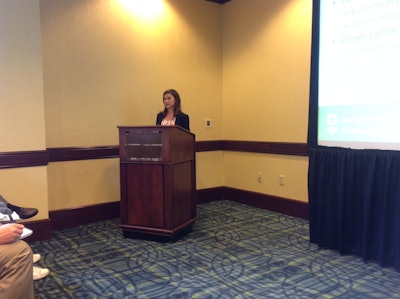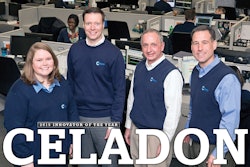 Marie Leapley, vice president of customer service at Celadon Trucking, spoke during the CCJ Spring Symposium on May 19.
Marie Leapley, vice president of customer service at Celadon Trucking, spoke during the CCJ Spring Symposium on May 19.During a technology breakout session at the CCJ Spring Symposium on May 19, Marie Leapley from Celadon Trucking, the CCJ 2015 Innovator of the Year, showcased the methodology and tools the company uses to score customers and loads in its network.
Leapley, vice president of customer service for the Indianapolis-based truckload carrier, began her career at Celadon as a Customer Service Representative (CSR). Her role changed to a Freight Analyst three years ago when the company restructured its customer service department by developing new software tools and changing job responsibilities.
As a CSR, she was assigned to a region and group of customer accounts along with about five other CSRs. As a Freight Analyst, she was assigned to one of six commodity groups — manufacturing, automotive, logistics, retail, food and beverage and home goods.
The tasks of order entry and appointment setting were removed from CSRs, freeing up time for this group to focus more on building relationships with customers, she said. Meanwhile, the company developed new job responsibilities and a decision support tool called Order Entry 2 (OE2) to optimally book freight in its network. OE2 uses a scoring methodology for customers and loads that considers pricing, capacity, profitability, lane commitments and much more.
For more details on how Celadon changed the job responsibilities in the department, see this section in Celadon’s Innovator of the Year article on CCJ Digital. For the career path Celadon created, go here.
Celadon also created three non-commodity groups: Customer Experience for onboarding new customers; Freight Analysis for analyzing freight opportunities that come into its network daily; and Utilization Analysis for working with customers to proactively set and amend appointments to remove slack time from driver schedules.
“We feel OE2 has really helped elevate us to next level as far as being able to choose best freight for our network,” she said.
Year over year, Celadon’s rates have gone up by six percent, its operating ratio has dropped by two percent, and layovers have “decreased significantly,” she said.
The software ranks each load on a scale of 1-10 with additional bonus points and “trump cards” that give its customer service department an easy way to make highly informed, profitable decisions. The categories used in OE2’s scoring system are explained in more detail here.
Several new features have been added to OE2 since CCJ reported on Celadon’s innovations in April. The system now instantly scores and stack-ranks orders that arrive from customers electronically. It also “talks” with a separate system the company uses called Load Analyzer from Manhattan Associates.
Load Analyzer gives instant recommendations for what customers and loads to solicit in order to move trucks into areas where they are needed to satisfy customer lane commitments. The recommendations include profitability and service metrics to help prioritize sales calls. Everyone in the customer service department is expected to solicit 7 loads per day.
With this latest enhancement, when Load Analyzer recommends a load for solicitation and the load is won, the order shows up in OE2 with a “trump card” for acceptance by the Freight Analysis team, Leapley said.












